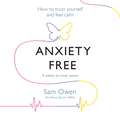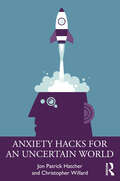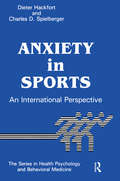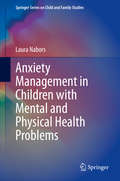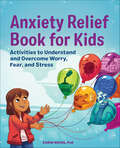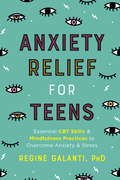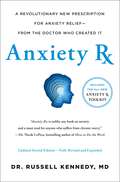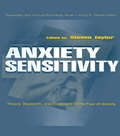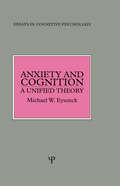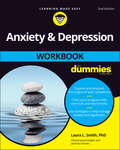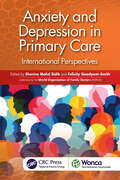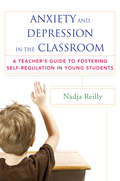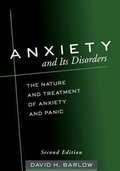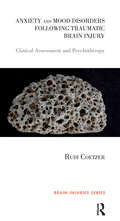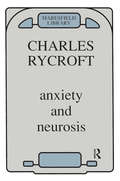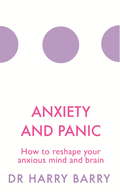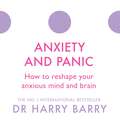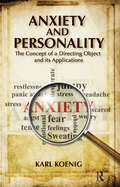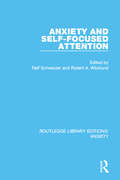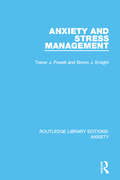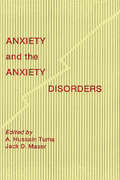- Table View
- List View
Anxiety Free: How to Trust Yourself and Feel Calm
by Sam OwenA PRACTICAL GUIDE TO RESOLVING ANXIETYIn today's fast-paced, always-on world, many of us experience anxiety of some kind. But it doesn't matter whether it's crippling your everyday life or you find it rearing its head in specific situations, there are ways to work through it - and this book will equip you with the know-how to do just that.Using her tried and tested three-pillar system - identify the cause, identify the solutions, take thoughtful action - acclaimed life coach Sam Owen explains that anxiety is not your enemy, it's an indication that something in your life isn't right. By activating the three pillars and using the practical tools and step-by-step guide Sam presents you with, you can root out what's going wrong and thereby resolve your anxiety within just four weeks - enabling you to get back to the calm and positivity you so deserve.Sam Owen's Anxiety Free has featured in/on:CosmopolitanGood HousekeepingPrimaNetdoctorRunners WorldStylist MagazineRefinery 29PsychologiesBBC Radio 5 LiveBBC Radio ScotlandBBC Radio ManchesterBBC Radio StokeRed Smart Women WeekNHS EnglandHuddersfield Literature FestivalTEDx
Anxiety Free: How to Trust Yourself and Feel Calm
by Sam OwenA PRACTICAL GUIDE TO RESOLVING ANXIETYIn today's fast-paced, always-on world, many of us experience anxiety of some kind. But it doesn't matter whether it's crippling your everyday life or you find it rearing its head in specific situations, there are ways to work through it - and this book will equip you with the know-how to do just that.Using her tried and tested three-pillar system - identify the cause, identify the solutions, take thoughtful action - acclaimed life coach Sam Owen explains that anxiety is not your enemy, it's an indication that something in your life isn't right. By activating the three pillars and using the practical tools and step-by-step guide Sam presents you with, you can root out what's going wrong and thereby resolve your anxiety within just four weeks - enabling you to get back to the calm and positivity you so deserve.
Anxiety Free: How to Trust Yourself and Feel Calm
by Sam OwenFacing challenges in your relationships, career, health or well-being? Worried important life goals seem to be slipping away? Whether you're faced with day-to-day nervous energy or experiencing a more crippling sensation of anxiety-induced panic attacks, sometimes life can test your nerves and stress levels. But there is a simple and effective way to facing your fears - both real and imagined threats, and making sure that you can bounce back from them stronger than ever before and go on to achieve your goals and lead a happier, more fulfilled life. The step-by-step guide helps you to recognise and understand the symptoms of anxiety better so you can manage your emotions, relationships and decisions better and take control of your own life.
Anxiety Hacks for an Uncertain World
by Christopher Willard Jon Patrick HatcherAnxiety Hacks for an Uncertain World is a highly accessible guide to anxiety disorders. It helps anxiety sufferers regain control by suggesting an array of useful tactics which when applied can be life altering. Chapters explore key topics such as phobias, panic disorders, social anxiety, general anxiety, pandemics, and more. Additional resources are included in the appendix, such as support groups, services, and helplines. Using light humor and examples from their lived experiences the authors relate to readers and offer useful suggestions to overcome anxiety and understand it. This book will be essential for anyone suffering from anxiety and phobias or professionals working with this population. It can be used on its own or in conjunction with therapy.
Anxiety In Sports: An International Perspective (Series in Health Psychology and Behavioral Medicine)
by Dieter Hackfort; Charles D. SpielbergerThis work offers an investigation of sports-related anxiety research, including studies from both Eastern and Western Europe. International authorities have combined chapters yo fous on three key areas of interest: theory and assessment, anxiety and performance, and anxiety control in sports.
Anxiety Management in Children with Mental and Physical Health Problems (Springer Series on Child and Family Studies)
by Laura NaborsThis book examines the implications of anxiety for children who have different types of comorbid mental health problems or chronic physical illnesses. It describes the differences between anxiety and fear in children and addresses how anxiety presents in children. The book presents ideas for treatment of anxiety in children and adolescents using examples and case studies. Chapters review evidence-based practices and explore common challenges in managing anxiety in school and community settings. In addition, chapters offer recommendations for improving social and emotional functioning and reducing anxiety symptoms, along with practical guidelines for working with children in therapy settings. Topics featured in this book include:The co-occurrence of anxiety and depression in children and adolescents.The appearance of anxiety before or after substance abuse.Typical and atypical presentations of anxiety in children with autism spectrum disorder.Chronic illness and anxiety in young children.Family-oriented cognitive behavior therapy and its use in children with Attention-Deficit/ Hyperactivity Disorder.The potential relationship between conduct disorder and oppositional defiant disorder, and anxiety. Anxiety Management in Children with Mental and Physical Health Problems is a must-have resource for researchers, professors, and graduate students as well as clinicians and other practitioners in clinical child and school psychology, social work, public health, family studies, educational psychology and counseling, health education, and allied disciplines.
Anxiety Relief Book for Kids: Activities to Understand and Overcome Worry, Fear, and Stress
by Ehrin WeissHelp kids find freedom from anxiety with engaging activities for ages 8 to 12Dealing with anxiety is tough, but with the right tools, kids can learn how to handle it in a healthy way so they can get back to the fun of being a kid. Anxiety Relief Book for Kids is the perfect introduction to anxiety books for kids, full of information and exercises to help kids build skills for finding peace and facing their fears with confidence.This standout among anxiety books for kids includes:An understanding of worries—Unlike many other anxiety books for kids, this one teaches them where worries come from, what they feel like, and ways to conquer them.Real-life solutions—Kids will learn to notice when their worries are causing problems, recognize what their feelings are trying to tell them, and come up with ideas for making their worries feel smaller.A range of fun activities—Writing, drawing, and meditating will help kids calm their bodies and quiet their thoughts.Proven strategies—Kids can start finding relief through exercises based in mindfulness, cognitive behavioral therapy, and exposure therapy.Help kids show their worries who's boss with help from this empowering choice in anxiety books for kids.
Anxiety Relief for Teens: Essential CBT Skills and Self-Care Practices to Overcome Anxiety and Stress
by Regine GalantiIs anxiety disrupting your life? With proven CBT-based skills and mindfulness techniques, this book can be your guide out of the spiraling stress of anxiety and get you back on track to living a happy and healthy life. Getting good grades, keeping up with social media, maintaining friendships... you have a lot on your plate and it's more difficult when you add anxiety to the mix. You may even be avoiding situations, events, or people that could trigger your anxiety. So, how do you stop yourself from missing out on life? With Anxiety Relief for Teens, Dr. Regine Galanti teaches you how CBT-based skills and mindfulness techniques can help you manage your anxiety and reverse negative patterns. Through simple and effective exercises that help you change your thoughts, behaviors, and physical reactions, this helpful guide gives you the tools you need to navigate all of life's challenges.Anxiety Relief for Teens features: • Quizzes and self-assessments to better understand your anxiety and emotions and discover their respective triggers. • 30+ CBT-based tools to manage your anxiety along with practical strategies for dealing with challenging emotions such as anger and sadness. • 30+ mindfulness practices to cope with your anxiety in the present moment through visualizations, breathing, meditation, and other exercises.
Anxiety Rx: A Revolutionary New Prescription for Anxiety Relief—from the Doctor Who Created It
by Russell KennedyFrom physician and neuroscientist Russell Kennedy, MD comes an award-winning book that offers a revolutionary, life-changing approach to healing anxiety. Break the cycle of anxiety with the newly upgraded and expanded second edition. After years of trying different therapies for his debilitating anxiety without success, Dr. Russell Kennedy had an epiphany: anxiety does not start in the brain.Anxiety starts in the body, where trauma is stored and physical and emotional perception begin. Alarm bells originating in the body are what trigger those anxious thoughts that we call anxiety, and Russ realized that true healing starts only when we learn not to conflate the two. He understood that existing therapies focused only on the mind would never get to the root of the problem—at best, they could help manage symptoms, but they’d never truly heal anxiety.Wanting to make a difference for the millions who suffer from anxiety disorder, Russ created Anxiety Rx, a book that blends his personal story with medical science, neuroscience, and developmental psychology. Readers learn how to sever the connection between the somatic alarm and the flood of anxious thoughts—in the process they begin to heal old trauma and gain a sense of control previously unknown.Russ offers techniques not only for our thinking minds, but for our feeling bodies, changing not just our mindset, but our “body-set.” Unraveling the intricate relationship between anxiety, the body, and the mind, Anxiety Rx offers a profound path toward healing and growth.
Anxiety Sensitivity: theory, Research, and Treatment of the Fear of Anxiety
by Steven TaylorAnxiety sensitivity (AS) is the fear of anxiety sensations which arises from beliefs that these sensations have harmful somatic, social, or psychological consequences. Over the past decade, AS has attracted a great deal of attention from researchers and clinicians with more than 100 peer-reviewed journal articles published. In addition, AS has been the subject of numerous symposia, papers, and posters at professional conventions. Why this growing interest? Theory and research suggest that AS plays an important role in the etiology and maintenance of many forms of psychopathology, including anxiety disorders, depression, chronic pain, and substance abuse. Bringing together experts from a variety of different areas, this volume offers the first comprehensive state-of-the-art review of AS--its conceptual foundations, assessment, causes, consequences, and treatment--and points new directions for future work. It will prove to be an invaluable resource for clinicians, researchers, students, and trainees in all mental health professions.
Anxiety and Cognition: A Unified Theory (Essays in Cognitive Psychology)
by Michael EysenckIt is argued in this book that there are three major approaches to anxiety. First, there is anxiety as an emotional state. Second, there is trait anxiety as a dimension of personality. Third, there is anxiety as a set of anxiety disorders. What is attempted is to produce a unified theory of anxiety which integrates all these major approaches. According to this unified theory, there are four sources of information which influence the level of experienced anxiety: (1) experimental stimulation; (2) internal physiological activity; (3) internal cognitions, (e.g., worries); and (4) one's own behaviour. The unified theory is essentially based on a cognitive approach. More specifically, it is assumed that individual differences in experienced anxiety between those high and low in trait anxiety depend largely on cognitive biases. It is also assumed that the various anxiety disorders depend on cognitive biases, and that the main anxiety disorders differ in terms of the source of information most affected by such biases (e.g., social phobics have biased interpretation of their own behaviour). In sum, this book presents a general theory of anxiety from the cognitive perspective. It is intended that this theory will influence theory and research on emotion, personality, and the anxiety disorders.
Anxiety and Depression Workbook For Dummies
by Laura L. SmithTackle anxiety and depression head-on with this practical workbook If you're one of the millions of people affected by—or whose loved ones are affected by—anxiety and depression, you're probably looking for strategies to help subdue or even transcend these debilitating and painful disorders. In that case, Anxiety and Depression Workbook For Dummies is a great place to start. This book is filled with chapters that cut across diagnostic categories, incorporating treatment techniques based on Cognitive Behavioral Therapy, Acceptance and Commitment Therapy, Emotion Focused Therapy, and Interpersonal Therapy. Use the techniques explored in this book to start making real changes, which can quickly lead to you feeling better. It also includes: Practical and hands-on descriptions of mindfulness-based practices you can implement immediately Brand-new updates to reflect modern changes in technology, social media, and the prevalence of loneliness Consideration of the pros and cons of medications and other biological interventions for depression and anxiety, including exploration of the placebo effect Additional worksheets online available for download Perfect for anyone trying to work through the challenging issues presented by anxiety and depression, for those trying to help a loved one do the same thing, or for those in therapy, this book is an excellent supporting resource that can help contribute to positive changes in the lives of people affected by emotional distress.
Anxiety and Depression in Children and Adolescents: Assessment, Intervention, and Prevention
by Thomas J. HubertyAlthough generally considered adult disorders, anxiety and depression are widespread among children and adolescents, affecting academic performance, social development, and long-term outcomes. They are also difficult to treat and, especially when they occur in tandem, tend to fly under the diagnostic radar. Anxiety and Depression in Children and Adolescents offers a developmental psychology perspective for understanding and treating these complex disorders as they manifest in young people. Adding the school environment to well-known developmental contexts such as biology, genetics, social structures, and family, this significant volume provides a rich foundation for study and practice by analyzing the progression of pathology and the critical role of emotion regulation in anxiety disorders, depressive disorders, and in combination. Accurate diagnostic techniques, appropriate intervention methods, and empirically sound prevention strategies are given accessible, clinically relevant coverage. Illustrative case examples and an appendix of forms and checklists help make the book especially useful. Featured in the text: Developmental psychopathology of anxiety, anxiety disorders, depression, and mood disorders. Differential diagnosis of the anxiety and depressive disorders. Assessment measures for specific conditions. Age-appropriate interventions for anxiety and depression, including CBT and pharmacotherapy. Multitier school-based intervention and community programs. Building resilience through prevention. Anxiety and Depression in Children and Adolescents is an essential reference for practitioners, researchers, and graduate students in school and clinical child psychology, mental health and school counseling, family therapy, psychiatry, social work, and education.
Anxiety and Depression in Primary Care: International Perspectives (WONCA Family Medicine)
by Felicity Goodyear-Smith Sherina Mohd SidikThis book provides practical information about depression and anxiety in primary care, with a focus on the approach in different countries and incorporating global ranges/prevalence, risk factors and health burden including that associated with COVID-19 and its pandemic. To ensure the challenges of a wide international primary care community are reflected fully, authors from different world regions – Africa, Asia Pacific, East Mediterranean, Europe, IberoAmericana-CIMF, North America and South Asia – have co-contributed to individual chapters on the detection and management of depression and anxiety in primary care in their own countries, including the screening tools used, how widely these tools are adopted and by whom, and current policies. As well as the medical model, it also presents the alternative viewpoint that feeling low or anxious is part of the human condition and the attention should be on supporting people in their journey through life, struggling to deal with the mainly social challenges they meet, rather than defining these problems as disorders or diseases requiring identification and treatment. Key Features: Explores the instruments used for the detection of depression and anxiety in primary care in various countries, and why and how these instruments are being used Describes the pharmaceutical and non-drug interventions for treating depression and anxiety in primary care and compares the similarities and differences in detecting and managing depression and anxiety in primary care among different countries Includes in-depth regional examples of how screening tools are used in practice and how policies can be established in the management of depression and anxiety in primary care Concludes with lessons learned from various countries and from different stakeholders with clear advice on what to do and, importantly, what not to do Addressing primary care detection and management of mental health issues across the globe, the book will be an invaluable practical aid for family medicine practitioners and the wider primary and community care teams and a useful reference for those involved in policy setting at regional and national levels including ministries of health.
Anxiety and Depression in the Classroom: A Teacher's Guide to Fostering Self-Regulation in Young Students
by Nadja ReillyGuidance for teachers on two pressing problems in student mental health. Anxiety and depression are two of the most common mental health problems for young students, and can be particularly hard to detect and support. In this book, the first of its kind for teachers, Nadja Reilly lays out with richly detailed examples the signs to look for so educators can direct their students to help and ensure emotional wellness in the classroom. Grounded in recent psychological research and practical self-regulation tools, Reilly opens her study out onto nourishing emotional wellness in all students, communicating with parents, and schoolwide mental health advocacy.
Anxiety and Its Disorders, Second Edition
by David H. BarlowThis landmark work is indispensable for anyone studying anxiety or seeking to deliver effective psychological and pharmacological treatments. David H. Barlow comprehensively examines the phenomena of anxiety and panic, their origins, and the roles that each plays in normal and pathological functioning. Chapters coauthored by Barlow with other leading experts then outline what is known about the classification, presentation, etiology, assessment, and treatment of each of the DSM-IV anxiety disorders. A definitive resource for researchers and clinicians, this is also an ideal text for graduate-level courses.
Anxiety and Mood Disorders Following Traumatic Brain Injury: Clinical Assessment and Psychotherapy (The Brain Injuries Series)
by Rudi CoetzerWhile there are many excellent texts addressing cognitive impairment and behavioural difficulties and on rehabilitation associated with traumatic brain injury, few textbooks specifically address the most common emotional problems that can have such an adverse effect on rehabilitation and outcome. Uniquely this book deals exclusively with the identification and psychotherapeutic management of mood and anxiety disorders after traumatic brain injury. Furthermore, a systematic approach to identifying and diagnosing anxiety and mood disorders is followed throughout the text. As well as providing an introduction to anxiety and mood disorders after traumatic brain injury, it provides a psychological perspective on their evolution and management. It is aimed at a range of professionals in training (or those responsible for providing training in psychopathology, neuropsychology and psychotherapy), as well as those who may have an interest in working with the type of patients with anxiety or depression, commonly seen in post-acute brain injury rehabilitation settings. Case studies, summaries and suggested references for further reading are used throughout to facilitate understanding and teaching where relevant.
Anxiety and Neurosis (Maresfield Library)
by Charles RycroftAnxiety may be debilitating or stimulating; it can result in neurotic symptoms or in improved, heightened performance in an actor or athlete. It is something every human being has experienced. As Professor G. M. Carstairs points out in his Foreword: 'During the course of the twentieth century we have found it progressively easier to concede that we are all to often swayed by emotion rather than reason. We have come to recognize the symptoms of neurotically ill patients are only an exaggeration of experiences common to us all, and hence that the unraveling of the psychodynamics of neurosis can teach us more about ourselves'. Although Charles Rycroft is also a psychoanalyst, it is as a biologist that he has made this study of anxiety, the three basic responses to it - attack, flight or submission - and the obsessional, phobic and schizoid and hysterical defenses. Written in precise but everyday language, Anxiety and Neurosis is based on adult experiences rather than the speculative theories of infantile instinctual development. Its clarity and authority can only add to Dr Rycroft's established international reputation.
Anxiety and Panic: How to reshape your anxious mind and brain
by Harry BarryTHE NUMBER 1 INTERNATIONAL BESTSELLER'Holds the key to easing the mental torture of those who have endured a lifelong struggle with the symptoms of acute and chronic anxiety. A unique book by a unique doctor' IRISH TIMESA practical guide to understanding, managing and overcoming anxiety and panic attacks by bestselling author and GP Harry Barry. Do you or does someone you love suffer from general anxiety, social anxiety, panic attacks, a phobia, obsessive-compulsive disorder or post-traumatic stress disorder? Or are you a health-care worker treating people with these disorders? Then this book is for you. Dr Harry Barry combines a deep knowledge of the inner workings of the mind and brain with a wealth of experience treating patients as a GP to offer a way out of the fear, worry and shame of anxiety. In this wise, supportive book, Dr Barry explains clearly and simply what it is about our minds and brains that generates the symptoms of anxiety. Through a series of case studies based on his real-life experiences treating patients, he explains and demonstrates how to use lifestyle changes, mindfulness, exercise and CBT techniques to cope with these symptoms and ultimately feel better.Previously published as Flagging Anxiety: How to Reshape Your Anxious Mind and Brain, this edition has been fully revised and updated.
Anxiety and Panic: How to reshape your anxious mind and brain (The Flag Series #1)
by Dr Harry BarryTHE NUMBER 1 INTERNATIONAL BESTSELLER'Holds the key to easing the mental torture of those who have endured a lifelong struggle with the symptoms of acute and chronic anxiety. A unique book by a unique doctor' IRISH TIMESA practical guide to understanding, managing and overcoming anxiety and panic attacks by bestselling author and GP Harry Barry. Do you or does someone you love suffer from general anxiety, social anxiety, panic attacks, a phobia, obsessive-compulsive disorder or post-traumatic stress disorder? Or are you a health-care worker treating people with these disorders? Then this book is for you. Dr Harry Barry combines a deep knowledge of the inner workings of the mind and brain with a wealth of experience treating patients as a GP to offer a way out of the fear, worry and shame of anxiety. In this wise, supportive book, Dr Barry explains clearly and simply what it is about our minds and brains that generates the symptoms of anxiety. Through a series of case studies based on his real-life experiences treating patients, he explains and demonstrates how to use lifestyle changes, mindfulness, exercise and CBT techniques to cope with these symptoms and ultimately feel better.Previously published as Flagging Anxiety: How to Reshape Your Anxious Mind and Brain, this edition has been fully revised and updated.
Anxiety and Panic: How to reshape your anxious mind and brain (The Flag Series #7)
by Dr Harry BarryTHE NUMBER 1 INTERNATIONAL BESTSELLER'Holds the key to easing the mental torture of those who have endured a lifelong struggle with the symptoms of acute and chronic anxiety. A unique book by a unique doctor' IRISH TIMESA practical guide to understanding, managing and overcoming anxiety and panic attacks by bestselling author and GP Harry Barry. Do you or does someone you love suffer from general anxiety, social anxiety, panic attacks, a phobia, obsessive-compulsive disorder or post-traumatic stress disorder? Or are you a health-care worker treating people with these disorders? Then this book is for you. Dr Harry Barry combines a deep knowledge of the inner workings of the mind and brain with a wealth of experience treating patients as a GP to offer a way out of the fear, worry and shame of anxiety. In this wise, supportive book, Dr Barry explains clearly and simply what it is about our minds and brains that generates the symptoms of anxiety. Through a series of case studies based on his real-life experiences treating patients, he explains and demonstrates how to use lifestyle changes, mindfulness, exercise and CBT techniques to cope with these symptoms and ultimately feel better.Previously published as Flagging Anxiety: How to Reshape Your Anxious Mind and Brain, this edition has been fully revised and updated.Written and Read by Dr Harry Barry(p) Orion Publishing Group 2018
Anxiety and Personality: The Concept of a Directing Object and its Applications
by Karl KoenigThe concept of a "directing object" is based on extensive clinical observations linked to a combination of ego psychology and object relations theory in the tradition of Otto Kernberg and Anne Marie and Joseph Sandler. People with a phobic disposition are those who were not, during childhood, permitted to learn by trial and error and thus gain confidence in their actions. They did not learn to direct their own actions and did not develop confidence in their capability to act successfully. In their inner world, they did not establish an internal directing object. Thus, they now need an external directing object, who watches over them. This has considerable influence on interpersonal relationships and on work. Phobic persons can work without difficulty when there is a external directing object, but they will not be able to work without such a companion. In therapy, they use their therapist as a directing object, which can create the illusion that the phobic patient is already much better. However the patient will fall back into phobic symptomatology when the therapist is no longer available as a directing object. Applying the concept of a directing object helps to understand a phobic person's psychodynamics. This will improve the results of therapy, and also help phobic persons to compensate difficulties arising from the lack of a companion, and deal with difficulties in finding and keeping one. Therapy can help them to develop their own internal directing object.
Anxiety and Self-Focused Attention (Routledge Library Editions: Anxiety)
by Ralf Schwarzer Robert A. WicklundFirst published in 1991, this book consists of 13 articles that were originally published in the journal Anxiety Research. They address the topic of anxiety and self-focused attention from a variety of perspectives, representing recent advances in social, clinical and personality psychology at the time. As a whole, the book poses a stimulating theoretical challenge to traditional anxiety research, which had been dominated by psychometric issues, clinical case studies and stable personality constructs. The contributors share the view that anxiety is an emotional state of distress dependent upon specific antecedent cognitive processes such as self-awareness, perceived role discrepancy or unfavourable expectancies.
Anxiety and Stress Management (Routledge Library Editions: Anxiety #3)
by Trevor J. Powell Simon J. EnrightMost stress is a normal part of daily life, and can be coped with adequately by the individual. Prolonged or more serious stress however may require professional help. A local GP can often provide this but in many cases will refer the client to a mental health worker or other health professional. Originally published in 1990, this title was written for each of these groups: as a practical handbook and guide for those professionals working in the field of mental health, but also written for the referring GP and those seeking help themselves. The authors integrate theoretical and academic material relating to anxiety and stress research with clinical experience. The book begins with a theoretical section offering a working model of stress, a guide to diagnostic classification, and alternative models of anxiety. This is followed by chapters on assessment, explaining the problem and treatment procedures to the client, teaching specific self-help skills, and changing stressful lifestyles. Advice is also given on running anxiety and stress management groups, and individual case studies are examined. The authors make extensive use of analogy and metaphor to ensure ready understanding and recall. They also include many useful inventories, questionnaires, charts and client handouts. Anxiety and Stress Management will be of use to all health professionals working with people who have anxiety and stress related problems, but will prove equally valuable for the clients themselves as a reference book and as a means of self-education and self-help.
Anxiety and the Anxiety Disorders
by A. Hussain Tuma and Jack MaserThe 1980s have been called the decade of anxiety. Not only is this true of the popular press, but students of behavior and psychopathology have contributed to the rather sudden reemergence of anxiety as a respectable and fascinating field of investigation. This volume is a culmination of more than two years of planning, literature reviews, writing, conference discussions, revising of original papers, and integrating the material for final publication. It is a series of interrelated statements about research on anxiety and the anxiety disorders written by many of the leading investigators currently active in this field. First published in 1985. Routledge is an imprint of Taylor & Francis, an informa company.

